介词短语置于句置时的倒装
- 格式:doc
- 大小:16.00 KB
- 文档页数:2
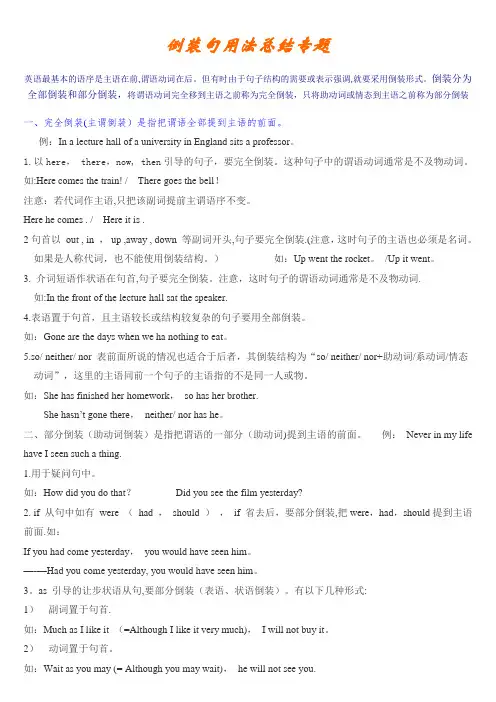
倒装句用法总结专题英语最基本的语序是主语在前,谓语动词在后。
但有时由于句子结构的需要或表示强调,就要采用倒装形式。
倒装分为全部倒装和部分倒装,将谓语动词完全移到主语之前称为完全倒装,只将助动词或情态到主语之前称为部分倒装一、完全倒装(主谓倒装)是指把谓语全部提到主语的前面。
例:In a lecture hall of a university in England sits a professor。
1.以here, there,now, then引导的句子,要完全倒装。
这种句子中的谓语动词通常是不及物动词。
如:Here comes the train! / There goes the bell!注意:若代词作主语,只把该副词提前主谓语序不变。
Here he comes . / Here it is .2句首以out , in ,up ,away , down 等副词开头,句子要完全倒装.(注意,这时句子的主语也必须是名词。
如果是人称代词,也不能使用倒装结构。
)如:Up went the rocket。
/Up it went。
3. 介词短语作状语在句首,句子要完全倒装。
注意,这时句子的谓语动词通常是不及物动词.如:In the front of the lecture hall sat the speaker.4.表语置于句首,且主语较长或结构较复杂的句子要用全部倒装。
如:Gone are the days when we ha nothing to eat。
5.so/ neither/ nor 表前面所说的情况也适合于后者,其倒装结构为“so/ neither/ nor+助动词/系动词/情态动词”,这里的主语同前一个句子的主语指的不是同一人或物。
如:She has finished her homework,so has her brother.She hasn’t gone there,neither/ nor has he。
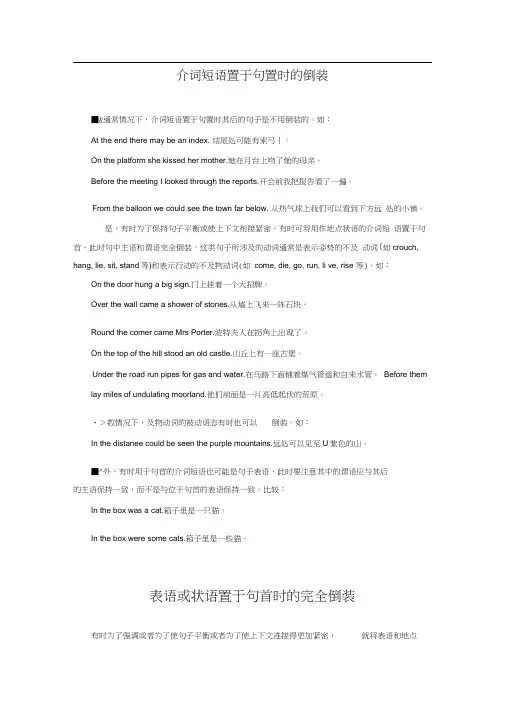
介词短语置于句置时的倒装■&通常情况下,介词短语置于句置时其后的句子是不用倒装的。
如:At the end there may be an index. 结尾处可能有索弓丨。
On the platform she kissed her mother.她在月台上吻了她的母亲。
Before the meeting I looked through the reports.开会前我把报告看了一遍。
From the balloon we could see the town far below. 从热气球上我们可以看到下方远处的小镇。
是,有时为了保持句子平衡或使上下文衔接紧密,有时可将用作地点状语的介词短语置于句首,此时句中主语和谓语完全倒装。
这类句子所涉及的动词通常是表示姿势的不及动词(如crouch, hang, lie, sit, stand等)和表示行动的不及物动词(如come, die, go, run, li ve, rise 等)。
如:On the door hung a big sign.门上挂着一个大招牌。
Over the wall came a shower of stones.从墙上飞来一阵石块。
Round the comer came Mrs Porter.波特夫人在拐角上出现了。
On the top of the hill stood an old castle.山丘上有一座古堡。
Under the road run pipes for gas and water.在马路下面铺着煤气管道和自来水管。
Before them lay miles of undulating moorland.他们前面是一片高低起伏的荒原。
・>数情况下,及物动词的被动语态有时也可以倒装。
如:In the distanee could be seen the purple mountains.远处可以见至U紫色的山。
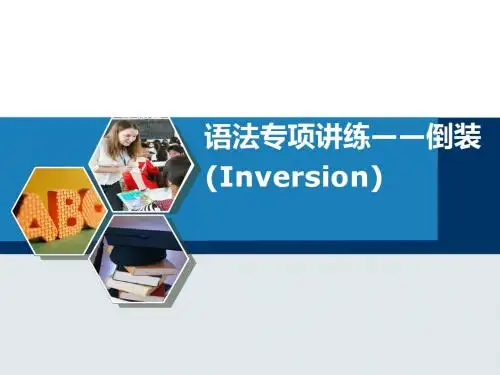

倒装句、祈使句倒装句、祈使句倒装句英语句子的自然语序是主语在前,谓语在后。
把谓语放在主语之前,就叫做倒装。
全部谓语放在主语之前,叫做全部倒装;只把部分谓语即be动词、助动词或情态动词放在主语之前,叫做部分倒装。
1. 存在句(there be/ live/ stand/ lie/ seem等)需要全部倒装。
如:There once lived an old hunter in the house.这所房子里曾住过一位老猎人。
There seems to be many listeners.似乎有很多听众。
2. 副词here, there, now, then等置于句首(经常与go, come等动词连用),全句需要全部倒装。
如:Here comes the bus. 公共汽车来了。
Now comes your turn. 现在轮到你了。
注意:如果主语是人称代词则不用倒装。
如:Here they are. Here it is.他们在这儿。
3. 介词短语作为地点状语置于句首,后面如果有lie, live, sit, stand, come, go等动词,全句需要全部倒装。
如: Into the hall came three women.大厅里走进来三位妇女。
In the east of the school lies a big bookshop.学校的东边有一个大的书店。
4. 当上文所表达的含义也适用于另一个人或物时,要用so/ neither/ nor+be/ 助词/ 情态动词+主语;此时谓语的时态、语态应与前句谓语的时态、语态相一致。
如:—I have finished my homework.我已经做完作业了。
—So has he. 他也做完了。
—I haven’t seen that film. 我没看过那部电影。
—Neither (Nor) have I. 我也没有。
5. not only... but also...连接两个并列句,且not only置于句首时,前句需要部分倒装。
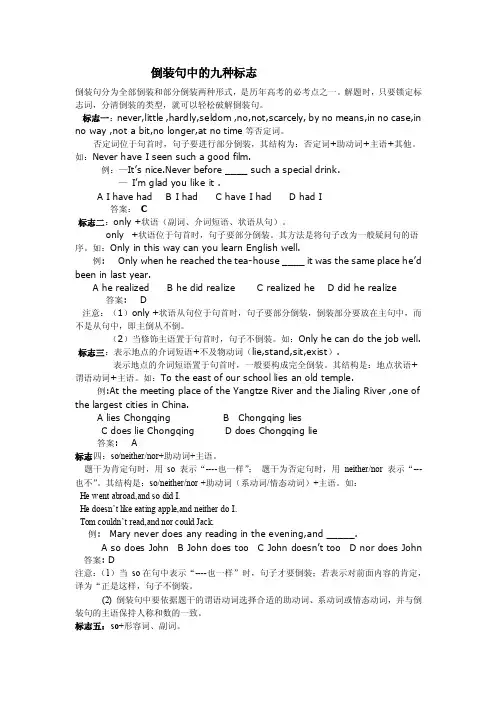
倒装句中的九种标志倒装句分为全部倒装和部分倒装两种形式,是历年高考的必考点之一。
解题时,只要锁定标志词,分清倒装的类型,就可以轻松破解倒装句。
标志一:never,little ,hardly,seldom ,no,not,scarcely, by no means,in no case,in no way ,not a bit,no longer,at no time等否定词。
否定词位于句首时,句子要进行部分倒装,其结构为:否定词+助动词+主语+其他。
如:Never have I seen such a good film.例:—It’s nice.Never before ____ such a special drink.—I’m glad you like it .A I have hadB I hadC have I hadD had I答案:C标志二:only +状语(副词、介词短语、状语从句)。
only +状语位于句首时,句子要部分倒装。
其方法是将句子改为一般疑问句的语序。
如:Only in this way can you learn English well.例: Only when he reached the tea-house ____ it was the same place he’d been in last year.A he realizedB he did realizeC realized heD did he realize答案: D注意:(1)only +状语从句位于句首时,句子要部分倒装,倒装部分要放在主句中,而不是从句中,即主倒从不倒。
(2)当修饰主语置于句首时,句子不倒装。
如:Only he can do the job well. 标志三:表示地点的介词短语+不及物动词(lie,stand,sit,exist).表示地点的介词短语置于句首时,一般要构成完全倒装。


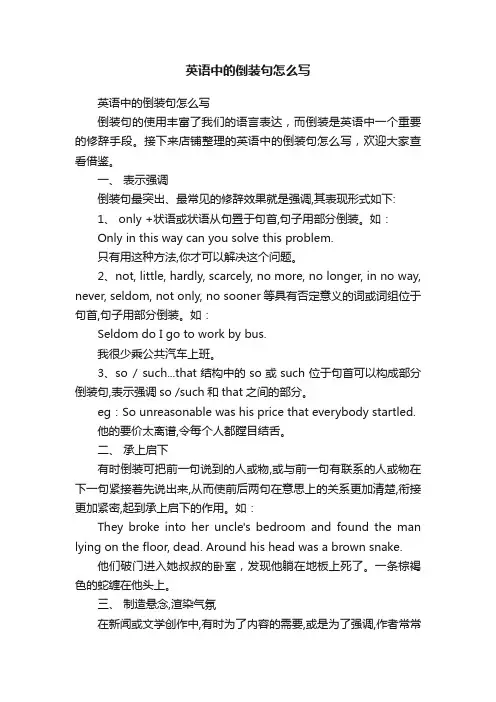
英语中的倒装句怎么写英语中的倒装句怎么写倒装句的使用丰富了我们的语言表达,而倒装是英语中一个重要的修辞手段。
接下来店铺整理的英语中的倒装句怎么写,欢迎大家查看借鉴。
一、表示强调倒装句最突出、最常见的修辞效果就是强调,其表现形式如下:1、 only +状语或状语从句置于句首,句子用部分倒装。
如:Only in this way can you solve this problem.只有用这种方法,你才可以解决这个问题。
2、not, little, hardly, scarcely, no more, no longer, in no way, never, seldom, not only, no sooner等具有否定意义的词或词组位于句首,句子用部分倒装。
如:Seldom do I go to work by bus.我很少乘公共汽车上班。
3、so / such...that结构中的so或such位于句首可以构成部分倒装句,表示强调so /such和that之间的部分。
eg:So unreasonable was his price that everybody startled.他的要价太离谱,令每个人都瞠目结舌。
二、承上启下有时倒装可把前一句说到的人或物,或与前一句有联系的人或物在下一句紧接着先说出来,从而使前后两句在意思上的关系更加清楚,衔接更加紧密,起到承上启下的作用。
如:They broke into her uncle's bedroom and found the man lying on the floor, dead. Around his head was a brown snake.他们破门进入她叔叔的卧室,发现他躺在地板上死了。
一条棕褐色的蛇缠在他头上。
三、制造悬念,渲染气氛在新闻或文学创作中,有时为了内容的需要,或是为了强调,作者常常运用倒装来制造悬念,渲染气氛。
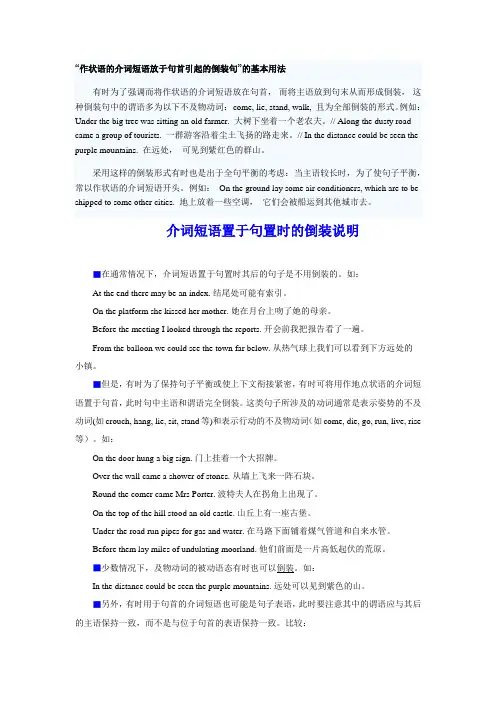
“作状语的介词短语放于句首引起的倒装句”的基本用法有时为了强调而将作状语的介词短语放在句首,而将主语放到句末从而形成倒装,这种倒装句中的谓语多为以下不及物动词:come, lie, stand, walk, 且为全部倒装的形式。
例如:Under the big tree was sitting an old farmer. 大树下坐着一个老农夫。
// Along the dusty road came a group of tourists. 一群游客沿着尘土飞扬的路走来。
// In the distance could be seen the purple mountains. 在远处,可见到紫红色的群山。
采用这样的倒装形式有时也是出于全句平衡的考虑:当主语较长时,为了使句子平衡,常以作状语的介词短语开头。
例如:On the ground lay some air conditioners, which are to be shipped to some other cities. 地上放着一些空调,它们会被船运到其他城市去。
介词短语置于句置时的倒装说明■在通常情况下,介词短语置于句置时其后的句子是不用倒装的。
如:At the end there may be an index. 结尾处可能有索引。
On the platform she kissed her mother. 她在月台上吻了她的母亲。
Before the meeting I looked through the reports. 开会前我把报告看了一遍。
From the balloon we could see the town far below. 从热气球上我们可以看到下方远处的小镇。
■但是,有时为了保持句子平衡或使上下文衔接紧密,有时可将用作地点状语的介词短语置于句首,此时句中主语和谓语完全倒装。
这类句子所涉及的动词通常是表示姿势的不及动词(如crouch, hang, lie, sit, stand等)和表示行动的不及物动词(如come, die, go, run, live, rise 等)。
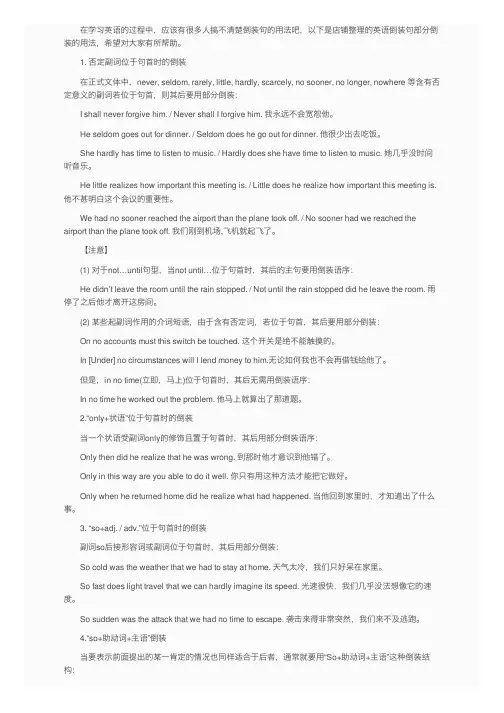
在学习英语的过程中,应该有很多⼈搞不清楚倒装句的⽤法吧,以下是店铺整理的英语倒装句部分倒装的⽤法,希望对⼤家有所帮助。
1. 否定副词位于句⾸时的倒装 在正式⽂体中,never, seldom, rarely, little, hardly, scarcely, no sooner, no longer, nowhere 等含有否定意义的副词若位于句⾸,则其后要⽤部分倒装: I shall never forgive him. / Never shall I forgive him. 我永远不会宽恕他。
He seldom goes out for dinner. / Seldom does he go out for dinner. 他很少出去吃饭。
She hardly has time to listen to music. / Hardly does she have time to listen to music. 她⼏乎没时间听⾳乐。
He little realizes how important this meeting is. / Little does he realize how important this meeting is.他不甚明⽩这个会议的重要性。
We had no sooner reached the airport than the plane took off. / No sooner had we reached the airport than the plane took off. 我们刚到机场,飞机就起飞了。
【注意】 (1) 对于not…until句型,当not until…位于句⾸时,其后的主句要⽤倒装语序: He didn’t leave the room until the rain stopped. / Not until the rain stopped did he leave the room. ⾬停了之后他才离开这房间。
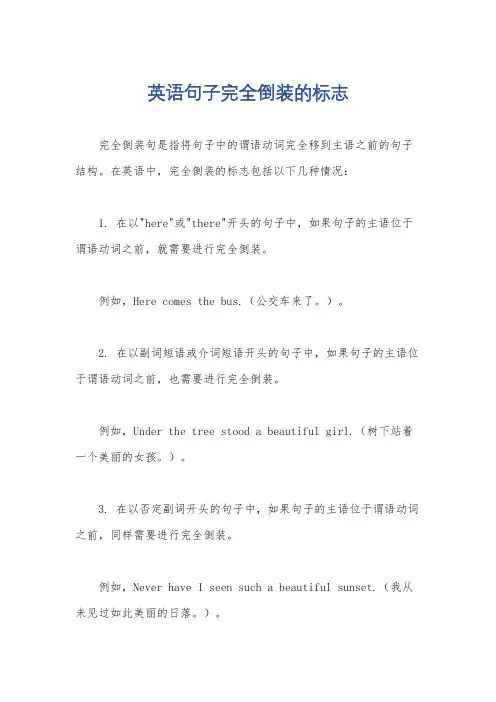
英语句子完全倒装的标志
完全倒装句是指将句子中的谓语动词完全移到主语之前的句子结构。
在英语中,完全倒装的标志包括以下几种情况:
1. 在以"here"或"there"开头的句子中,如果句子的主语位于谓语动词之前,就需要进行完全倒装。
例如,Here comes the bus.(公交车来了。
)。
2. 在以副词短语或介词短语开头的句子中,如果句子的主语位于谓语动词之前,也需要进行完全倒装。
例如,Under the tree stood a beautiful girl.(树下站着一个美丽的女孩。
)。
3. 在以否定副词开头的句子中,如果句子的主语位于谓语动词之前,同样需要进行完全倒装。
例如,Never have I seen such a beautiful sunset.(我从未见过如此美丽的日落。
)。
现在,让我们以"Here comes the bus"为题,写一篇文章吧。
部分倒装用法归纳部分倒装,即将主语与助动词倒置,其结构与一般疑问句大致相同。
英语中构成部分倒装的主要情形有:1. 含否定意义的词(如never, hardly, seldom, little, few, not until, not, not only, no sooner, no Ion ger, no where, by no mea ns 等)置于句首时,其后用咅B 分倒装。
如:Never have I seen read such a book. 我从未读过那样的书。
Little do we know his life.我们对他的生活了解得很少。
By no means should you tell him about it.你绝不要告诉他这事。
2. only加状语(副词/介词短语/从句)放在句首时,其后用部分倒装。
女口:Only in this way can you do it well.只有这样你才能做好。
Only when he returned home did he realize what had happened.当他回至U家里时,才知道出了什么事。
3. so / neither / nor表示前面所说的情况也适合于后者时,用" so / neither / nor+助动词+主语”这样的倒装句式。
女口:He can sing English songs and so can I.他会唱英语歌,我也会。
He didn ' slee the film, and neither did I.他没有看这部电影,我也没有看。
She is every beautiful and so was her mother when she was young.她很美,她妈妈年轻时也很美。
4. 当虚拟条件句含有were, should, had时,可省略if,将were, should, had置于句首。
倒装句的形式和用法倒装句是英语语法中常见的句子结构,主语与谓语动词的次序颠倒。
它在英语中具有一定的运用频率,常见于问句、条件句、方位表达等情景。
本文将深入探讨倒装句的形式和用法,以帮助读者更好地理解和掌握倒装句结构。
一、完全倒装句的形式完全倒装句是最常见的倒装句形式。
在完全倒装句中,谓语动词位于主语之前。
1. 在问句中“Where do you live?”(你住在哪里?)→ “Where live you?”(你住在哪里?)2. 在以介词短语开头的句子中“In the garden stood a beautiful flower.”(花园里有一朵美丽的花。
)→ “A beautiful flower stood in the garden.”(花园里有一朵美丽的花。
)3. 在以表示地点的状语或副词开头的句子中“Here comes the bus.”(汽车来了。
)→ “The bus comes here.”(汽车来了。
)二、部分倒装句的形式部分倒装句是指只将助动词、系动词或情态动词置于主语之前。
1. 在条件句中“If I were you, I would study harder.”(要是我是你,我会更加努力学习。
)→ “Were I you, I would study harder.”(要是我是你,我会更加努力学习。
)2. 在以“only”开头的句子中“Only by working hard can you achieve success.”(只有努力工作,你才能获得成功。
)→ “Only by working hard can you achieve success.”(只有努力工作,你才能获得成功。
)三、倒装句的用法1. 在强调句中“Jane has never been to Paris.”(简从未去过巴黎。
)→ “Never has Jane been to Paris.”(简从未去过巴黎。
倒装句常见结构及用法完全倒装结构及用法一、具有“地点”意义的副词、时间意义的副词,以及能表移动方向的副词放在句首,句子的主语是名词,谓语是连系动词或表示“位置移动”的单个不及物动词时,该动词放在主语前面。
如:There goes the bell.注意:当主语是人称代词时,尽管副词在句首,主谓不倒装。
如:Out they rushed.二、具有“方位”意义的介词短语或副词短语在句中作状语或表语放在句首,谓语是连系动词be,以及表示“位于、存在”或“位置移动”的单个不及物动词时,该动词放在主语前面。
如:Among the hens is a big cock.三、作表语的形容词或分词放在句首时,连系动词放在主语前面[英语语法]。
如:Present at the party were the ladies in the big city.四、全部倒挂就是把句子中的谓语动词全部放在主语之前。
所有触发器的常见结构是:1) here, there, now, then, thus等副词置于句首, 谓语动词常用be, e, go, lie, run。
There goes the bell.Then came the chairman.Here is your letter.2)表示运动方向的地点副词或状语放在句首,谓语表示运动动词。
Out rushed a missile from under the bomber.Ahead sat an old woman.注意:以上所有倒装句结构的主语必须是名词。
如果主语是人称代词,就不能完全倒装。
Here he es. Away they went.部分倒装结构及用法把谓语的助动词和情态动词放在主语前面,就是部分倒装。
在下列情况下会发生部分反转。
一、把“so ... that ...”句型中的“so + 形容词 / 副词”部分放在句首时,be动词或助动词放在主语前面。
完全倒装的四种主要类型1. here 和there位于句首时的倒装表示地点的here和there位于句首时,其后用完全倒装形式。
这类倒装句的谓语通常是动词be和come, go等表示移动或动态的不及物动词:Here’s Tom. 汤姆在这里。
There’s Jim. 吉姆在那儿。
Here comes the bus. 公共汽车来了。
There goes the bell. 铃响了。
There goes the last train. 最后一班火车开走了。
【注意】(1)以上倒装句中的谓语动词come和go不能用进行时态,即不能说Here is coming the bus。
(2)若主语为代词,则不倒装:Here I am. 我在这儿。
/ 我来了。
Here it comes. 它来了。
(3)其中的动词有时也可能是stand, lie, live等表示状态的动词(表示存在):There stood a desk against the wall. 靠墙放着一张书桌。
Once upon a time there lived a man known by the name of Beef. 从前有个人名叫比夫。
2. away和down等位于句首时的倒装地点副词away, down, in, off, out, over, round, up 等位于句首时,其后用完全倒装语序。
这类倒装句的谓语通常表示动态的不及物动词:Away went the runners. 赛跑选手们跑远了。
Round and round flew the plane. 飞机盘旋着。
The door opened and in came Mr Smith. 门开了,史密斯先生进了来。
Down came the rain and up went the umbrellas. 下雨了,伞都撑起来了。
【注意】若主语为人称代词,则不能用倒装:Away he went. 他跑远了。
高中英语倒装用法归纳倒装结构也是英语高考中常考的语法现象,该结构分为完全倒装和部分倒装。
所谓完全倒装是指整个谓语部分放在主语前面;而部分倒装是指谓语的一部分(情态动词或助动词)放在主语之前。
一、完全倒装结构㈠there be句型,引导词there 还可以接appear, exist, lie, remain, seem, stand, live 等词。
①There is a mobile phone and some books on the desk. 桌上有一个手机和一些书。
②There are thousands of people gathering on the square. 广场上聚集着成千上万的人③There lived an old fisherman in the village. 村里住着一位老渔夫。
④There stand two white houses by the river. 河滨矗立着两座白房子。
⑤There existed some doubt among the students. 学生中有些怀疑。
㈡用于here, there, now, thus, then +动词+主语的句型中(谓语动词多为be, go, come等)。
①Here comes the bus.汽车来了。
②There goes the bell. 铃响了。
③Now comes my turn. 轮到我了。
④Then came the order to take off. 起飞的命令到了。
㈢以out, in, up, down, off, away等副词开头,谓语动词是表示“移动”的意思。
如:go, come, leave等。
①Away went the crowd one by one. 人们一个一个地离去。
②In came a stranger in black. 进来了一位穿黑衣的陌生人。
部分倒装句的五种常用句式英语句子的主语通常位于谓语动词之前,这种语序被称为正常语序。
但有时出于修辞或某种特殊的语法结构的需要,需要将谓语动词放在主语之前,这种语序则叫倒装语序。
按倒装的形式,倒装可分为类,一是部分倒装,二是完全倒装。
前者指主语和助动词倒置,后者指主语和谓语完全倒置。
部分倒装即将主语与助动词倒置,其结构与一般疑问句大致相同。
英语中构成部分倒装的主要情形有以下几种:1. 在正式文体中,never, hardly, seldom, little, not until, not, not only, no sooner, no longer, nowhere, by no means 等含有否定意义的副词若位于句首,则其后要用部分倒装。
如:Seldom does he read in his free hours. 他空余时间很少看书。
By no means should he be left alone. 绝不能把他单独留下。
Hardly could the old man stand on his feet in the flaw. 老人在这阵狂风中几乎站不住了。
Never will you achieve anything if you spend your time that way. 你若总是这样消磨时间,就永远不会有所成就。
Not only did he speak more correctly, but he spoke more easily. 不仅他讲得更正确,也讲得更不费劲了。
Not until the rain stopped did he leave the room. 雨停了之后他才离开这房间。
注:某些起副词作用的介词短语,由于含有否定词,若位于句首,其后要用部分倒装。
如:In no case should you give up. 你绝不能放弃。
On no accounts can my name be mentioned to anyone. 我的名字是绝不能向任何人提起的。
介词短语置于句置时的倒装
■在通常情况下,介词短语置于句置时其后的句子是不用倒装的。
如:
At the end there may be an index. 结尾处可能有索引。
On the platform she kissed her mother. 她在月台上吻了她的母亲。
Before the meeting I looked through the reports. 开会前我把报告看了一遍。
From the balloon we could see the town far below. 从热气球上我们可以看到下方远处的小镇。
■但是,有时为了保持句子平衡或使上下文衔接紧密,有时可将用作地点状语的介词短语置于句首,此时句中主语和谓语完全倒装。
这类句子所涉及的动词通常是表示姿势的不及动词(如crouch, hang, lie, sit, stand等)和表示行动的不及物动词(如come, die, go, run, live, rise等)。
如:
On the door hung a big sign. 门上挂着一个大招牌。
Over the wall came a shower of stones. 从墙上飞来一阵石块。
Round the comer came Mrs Porter. 波特夫人在拐角上出现了。
On the top of the hill stood an old castle. 山丘上有一座古堡。
Under the road run pipes for gas and water. 在马路下面铺着煤气管道和自来水管。
Before them lay miles of undulating moorland. 他们前面是一片高低起伏的荒原。
■少数情况下,及物动词的被动语态有时也可以倒装。
如:
In the distance could be seen the purple mountains. 远处可以见到紫色的山。
■另外,有时用于句首的介词短语也可能是句子表语,此时要注意其中的谓语应与其后的主语保持一致,而不是与位于句首的表语保持一致。
比较:
In the box was a cat. 箱子里是一只猫。
In the box were some cats. 箱子里是一些猫。
表语或状语置于句首时的完全倒装
有时为了强调或者为了使句子平衡或者为了使上下文连接得更加紧密,就将表语和地点状语(多为介词短语)置于句首,谓语动词也常置于主语前,构成完全倒装。
如:
By the door stood an armed guard. 门口站着一名手持武器的士兵。
At the next table was a pretty girl waiting for someone. 隔壁桌上坐着一个等人的漂亮姑娘。
Among these people was his friend Jim. 他的朋友吉姆就在这些人当中。
By the window sat a young man with a magazine in his hand. 窗户边坐着一个年轻人,手里拿着一本杂志。
At the front of the book is a table of contents, giving details of what is in the book. 书的前部有目录,详列了书中的内容。
地点状语后的倒装
地点状语后面如有表示位置的动词 (如lie, live, sit, stand) 或转移的动词 (如c ome, go, rise),用作主语的名词可以放在动词之后。
这种情形主要出现在描写文中。
如:At the top of the hill stood the tiny chapel. 那座小教堂矗立在山顶上。
In the fields of poppies lay the dying soldiers. 罂粟地里躺着奄奄一息的士兵们。
别的动词如属被动语态也可以倒装。
In the distance could be seen the purple mountains. 远处可以见到紫色的山。
主语如是代词则不能倒装:
At the top of the hill it stood out against the sky. 它背衬青天矗立在山顶上。